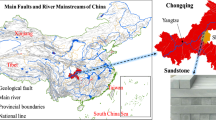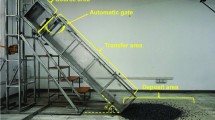Abstract
The foundations of dams containing soluble material, typically gypsum and limestone, undergo a dissolving process as a consequence of reservoir seepage. In due course, such dissolution of soluble material increases the volume of holes through which water may flow, in turn involving an increase in flow rate through the dam foundation. To adapt dam design to the particular conditions of these foundations, especially in foundations containing gypsum, with the main aims of delaying the dissolution process and avoiding damage or loss of functionality during dam lifespan, a procedure that models the dissolution process coupled with seepage phenomena is necessary. The objective of this paper is to provide this procedure and test it under experimental conditions. This entails coupling a conventional code for calculation of seepage networks, by means of the finite-element method, with a code developed by the authors to calculate the solution front advance (the zone where the dissolution is taking place). The procedure is verified by performing permeameter testing using sand and soluble material mixtures, with the tests being numerically modelled.











Similar content being viewed by others
Notes
FastSEEP program: graphical pre and post-processor of the program Seep2D, developed by Boss International. Seep2D was written by Fred Tracy of the US Army Engineer Waterways Experiment Station.
Dissolution2D program: developed by Luis Medina Martinez and Carmen María Baena Berrendero (2007) For the entire code, see Baena (2011).
Abbreviations
- A :
-
Area exposed to dissolution (L2)
- A f :
-
Acceleration factor
- C :
-
Concentration (M/L3)
- C s :
-
Concentration of saturation (M/L3)
- d :
-
Representative pore size (L)
- D 50 :
-
Sieve aperture that allows 50 % of the material to pass (L)
- g :
-
Gravity (L/T2)
- h 0 :
-
Constant head (in test) (L)
- i :
-
Hydraulic gradient
- i 0 :
-
Initial hydraulic gradient (in test)
- K :
-
Permeability coefficient (L/T)
- K d :
-
Dissolution rate constant (L/T). Usually K in bibliography
- K 0 :
-
Initial permeability coefficient (L/T)
- K td :
-
Permeability coefficient after dissolution (L/T)
- K i :
-
Intrinsic permeability (L2)
- M :
-
Mass of soluble solid (M)
- M ms :
-
Mass of soluble material (in test) (M)
- n :
-
Porosity
- n 0 :
-
Initial porosity
- Q :
-
Volumetric flow rate (L3/T)
- Q 0 :
-
Initial flow rate (L3/T)
- Q td :
-
Flow rate after dissolution (L3/T)
- Re :
-
Reynolds number
- S :
-
Surface of grain (L2)
- t :
-
Time (T)
- t ab :
-
Arriving time downstream (T)
- t u-cte :
-
Time for constant u (T)
- u :
-
Solution front velocity (L/T)
- u 0 :
-
Initial solution front velocity (L/T)
- v :
-
Seepage velocity (L/T)
- v 0 :
-
Initial seepage velocity (L/T)
- V :
-
Dissolution volume (L3)
- V g :
-
Volume of grain (L3)
- V t :
-
Soil volume (L3)
- V h :
-
Fraction for interconnected pore holes (L3)
- V s :
-
Fraction for soluble particles (L3)
- V in :
-
Fraction for insoluble particles (L3)
- ρ :
-
Density (M/L3)
- θ :
-
Order of the dissolution kinetic
- ν :
-
Viscosity (M/L/T)
- σ 0 :
-
Mass per unit volume of soluble particle (M/L3)
- ϕ :
-
Percentage in volume of soluble material
References
Araoz Sánchez-Albornoz A (1992) Cimentación de presas en terrenos terciarios con disolución de evaporitas y erosión interna en la Cuenca del Ebro. Rev Obras Públicas 139(3309):265–290
Baena CM (2011) Análisis de la filtración en presas con cimientos yesíferos. oa.upm.es/7211/. Tesis doctoral, UPM, Madrid
Calvino F, Costantino F, Mirri F (1981) Design criteria for a dam, reservoir and irrigation system on a Middle East evaporite formation. Bull Int Assoc Eng Geol 24:53–54
Carman PC (1956) Flow of gases through porous media. Butterworths Scientific Publications, London
Dreybrodt W, Romanov D, Gabrovsek F (2001) Dam sites in soluble rocks: a model of increasing leakage by dissolutional widening of fractures beneath a dam. Eng Geol 70:17–35
Dreybrodt W, Romanov D, Gabrovsek F (2002) Karstification below dam sites: a mode of increasing leakage from reservoirs. Environ Geol 45:518–524
Farid AM, Habibagahi G (2007) Dissolution-seepage coupled analysis through formations containing soluble materials. J Eng Mech 133(6):713–722
Flores CE, Rodríguez P (1967) Problemas de disolución de yesos en algunos sitios de presas. Boletín de la Sociedad Venezolana de Mecánica de Suelo e Ingeniería de Fundaciones: 3–14
Ghobadi MH, Khanlari GR, Djalaly H (2005) Seepage problems in the right abutment of the Shahid Abbaspour dam, southern Iran. Eng Geol 82:119–126
Gumusoglu MC, Ulker R (1982) The investigation of the effect of gypsum on foundation design. Bull Int Assoc Eng Geol 25:99–105
Guzina BJ, Saric M, Petrovic N (1991) Seepage and dissolution at foundations of a dam during the first impounding of the reservoir. In: XVII congress of ICOLD (Vienna) Q.66 R.78, pp 1459–1475
James AN (1977) Calcium sulphate in the foundations of major embankment dams. Q J Eng Geol 11:332–333 (summaries of papers read at the engineering regional meeting–Cardiff)
James AN (1982) Engineering properties of evaporitic rock. Bull Int Assoc Eng Geol 25:125–126
James AN (1992) Soluble materials in civil engineering. Ellis Horwood, New York
James AN, Edworthy KJ (1985) The effects of water interactions on engineering structures. Hydrol Sci J 30(3):395–406
James AN, Kirkpatrick IM (1980) Design of foundations of dams containing soluble rocks and soils. Q J Eng Geol Hydrogeol 13(3):189–198
James AN, Lupton ARR (1978) Gypsum and anhydrite in foundations of hydraulic structures. Geótechnique 28(3):249–272
James AN, Lupton ARR (1985) Further studies of the dissolution of soluble rocks. Geótechnique 35(2):205–210
James AN, Cooper AH, Holliday DW (1981) Solution of the gypsum cliff (Permian, Middle Marl) by the River Ure at Ripon Parks, North Yorkshire. In: Proceedings of Yorkshire Geological Society, vol 43, 4 (24), pp 433–450
Johnson KS (2008) Gypsum-karst problems in constructing dams in the USA. Environ Geol 53:945–950
Kolditz O, Bauer S, Bilke L, Böttcher N, Delfs JO, Fischer T, Görke UJ, Kalbacher T, Kosakowski G, McDermott CI, Park CH, Radu F, Rink K, Shao H, Shao HB, Sun F, Sun YY, Singh AK, Taron J, Walther M, Wang W, Watanabe N, Wu N, Xie M, Xu W, Zehner B (2012) OpenGeoSys: an open-source initiative for numerical simulation of thermo-hydro-mechanical/chemical (THM/C) processes in porous media. Environ Earth Sci 67(2):589–599. doi:10.1007/s12665-012-1546-x
Kolditz O, Görke UJ, Shao HB, Wang W, Shao H, Hudson JA, Feng XT (2013) Thermo-hydro-mechanical-chemical processes in fractured rock. In: 3rd ISRM symposium on rock characterisation, modelling an engineering design methods, SINOROCK 2013, Shanghai, 18–20 June 2013 (code 97711)
Kozeny J (1927) Ueber Kapillare Leitung des Wassers im Boden. Sitz Akad Wiss Wien 136(2):271–306
Liu S, Nancollas GH (1970) The kinetics of dissolution of calcium sulfate dihydrate. J Inorg Nucl Chem 23:2311–2316
Macau F, Riba O (1962) Situación, características y extensión de los terrenos yesíferos en España. In: I Coloquio Internacional sobre las Obras Públicas en terrenos yesíferos, vol V, C 0–1, pp 157–184
Milanović PT (2000) Geological engineering in karst. Zebra, Belgrade
Milanović PT (2004) Water resources engineering in karst. CRC, Boca Raton
Nedriga VP, Dem’yanova ÉA (1986) Construction of dams on soils containing soluble salts. Hydrotech Constr 20(2):116–121
Nernst WZ (1904) Theorie der Reaktionsgeschwindigkeit in heterogenen Systemen. Phys Chem 47:52–55
Samper J, Ayora C (1993) Acoplamiento de modelos de transporte de soluto y de modelos de reacciones químicas. Estud Geol 49:233–251
Steefel CI, Lasaga AC (1990) Evolution of dissolution patterns. Permeability change due to coupled flow and reaction. In: Chemical modelling of aqueous systems II, Chap 16, pp 212–223. American Chemical Society, Washington
Szymczak P, Ladd AJC (2012) Reactive-infiltration instabilities in rocks. Fracture dissolution. J Fluid Mech 702:239–264
Verhoef PNW (2009) Dam and canal design on soluble rock (West Gode Irrigation Project, Ethiopia). Geointernational 44–50
Yagüe J, Alonso M (1999) Control de filtraciones en cimientos erosionables de presas de materiales sueltos. VI Jorn Esp Presas (Málaga) 53:75–83
Yilmaz I (2001) Gypsum/anhydrite: some engineering problems. Bull Eng Geol Environ 59:227–230
Acknowledgments
We wish to show our appreciation to Raúl González Guijarro for his valuable help in the methodology and interpretation of the tests and Luis Medina Martínez for his assistance in writing Dissolution2D, as well as to the Geotechnical Laboratory at ETSICCP (UPM) and the Geotechnical Laboratory at CEDEX (Madrid).
Author information
Authors and Affiliations
Corresponding author
Rights and permissions
About this article
Cite this article
Baena, C.M., Toledo, M.Á. An experimentally verified model of the seepage progress due to dissolution of soluble particles in foundations subject to intergranular flow. Environ Earth Sci 72, 3369–3382 (2014). https://doi.org/10.1007/s12665-014-3243-4
Received:
Accepted:
Published:
Issue Date:
DOI: https://doi.org/10.1007/s12665-014-3243-4




